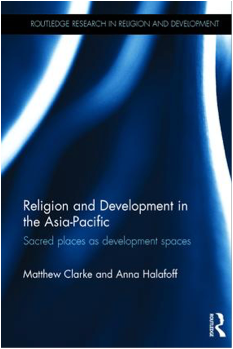
DARREN CRONSHAW looks at a scholarly text on in inter-relationships between faith and development spaces…
Matthew Clarke and Anna Halafoff
Religion and Development in the Asia-Pacific: Sacred places as development spaces
London: Routledge, 2017.
ISBN-13: 978-1138792364.

“The highest value and bulk of their book…is five Asian-Pacific case studies of how religion and development are interrelated. It is a fascinating multi-faith range – Christian, Buddhist, Muslim, Jewish and multi-faith, and a more holistic spirituality initiative – that demonstrates how religious places often undergird development initiatives by offering not just geographic space but trust, belonging and continuity with existing community rhythms.”
The spaces and places in which community development happens, and their relationship to religion, are centrally important but have not always been considered in development studies. Earlier schools of thought in development have minimised religion as a private issue, or blamed it as a bottleneck to development, or marginalised it compared to economic growth. Yet community development principles such as valuing the local ought to at least be aware of and at their best maximise the contribution of religion.
This is especially important in developing regions of the world where most communities and people revolve their lives around religion. Moreover, religions influence how people are motivated to help others and their sacred places are often used also as safe space for development and community safety. How, then, can we understand the interrelationships of religion and development, and in what ways are sacred places utilised to create space for community development?
Community development scholars Professor Matthew Clarke and Anna Halafoff address these questions in their recent volume Religion and Development in the Asia-Pacific: Sacred places as development spaces. Clarke is the head of School of Humanities and Social Sciences at Deakin University and has worked in the development sector for 20 years, initially with World Vision and now at Deakin focusing on religion and development, aid effectiveness, and measuring community well-being. Halafoff is senior lecturer in sociology at Deakin with a research expertise in multi-faith relations, and religion and peacebuilding.
As background they discuss the huge needs for aid and development, celebrate the progress of recent decades, admit the vulnerability with pressing global issues, and offer a categorisation of how religion has been treated in development studies. The highest value and bulk of their book, however, is five Asian-Pacific case studies of how religion and development are interrelated. It is a fascinating multi-faith range – Christian, Buddhist, Muslim, Jewish and multi-faith, and a more holistic spirituality initiative – that demonstrates how religious places often undergird development initiatives by offering not just geographic space but trust, belonging and continuity with existing community rhythms.
In Vanuatu, Christian churches have often been used not just for worship but for political activism, community education and sanctuary from natural disaster. Notably, the churches also offer in their teaching an impetus for development and for empowering women as well as men.
The Muslim Minhaj-ul-Quran International offers strong teaching refuting Taliban and al-Qaeda terrorist ideology, and a unique retreat centre offering food, shelter, charity and education especially during Ramadan.
The Buddhist Songdhammakalyani Monastery in Bangkok advocates strongly for Buddhist women and their leadership. It underlines these efforts with its sacred places named after Buddhist women with prominent female statues. The Buddhist nuns also take the sanctity of the monastery on visits to the detention centre or prison, or on alms rounds to share sacredness beyond any designated religious place.
The Kalani retreat centre and intentional community in Hawaii revolves around nature, wellness and local culture. Its vision is to foster a new heaven and new earth, starting with and learning from Hawaiian sacred places, self-development, yoga and permaculture, and a liberating approach to architecture that supports sustainable development.
Finally, the Jewish group “Stand Up” teaches Muslim Sudanese women in a Uniting Church in my home city of Melbourne. Participants say the multi-faith context adds to the sense of equality and richness of the program.
Religious places often house, as well as provide a religious imperative for, educational, disaster relief, environmental awareness and gender equality programs. It is helpful to understand the value places of worship bring to development, as well as more broadly how religious schools, yoga studios, permaculture gardens or virtual spaces can enhance locally appropriate development and advocacy for justice. Religion and Development in the Asia-Pacific is valuable reading for development scholars and practitioners to help enhance understanding of the importance of religion and religious places in development, especially for a multi-faith world.
This review was originally published in Pacific Journal of Baptist Studies (May 2017), 66-68





